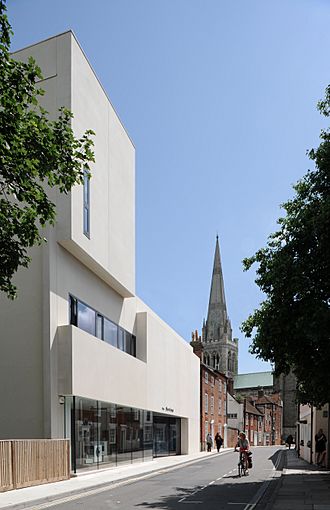The Novium facts for kids
Quick facts for kids The Novium |
|
|---|---|

The Novium, from Tower Street
|
|
| General information | |
| Type | Museum |
| Location | Tower Street, Chichester, West Sussex |
| Coordinates | 50°50′15″N 0°46′53″W / 50.8374°N 0.7813°W |
| Inaugurated | 2011/12 |
| Design and construction | |
| Architect | Keith Williams |
The Novium is a cool museum located in Chichester, a town in West Sussex, southern England. Its name comes from the ancient Roman name for Chichester, which was Noviomagus Reginorum.
The museum was designed by architect Keith Williams. It is a large building, about 1,300 square meters in size. That's more than twice the size of the old museum!
The Novium has three floors, and each floor has a special area for exhibitions. There's also a room for research and learning. Plus, it has a storage area for many historical items.
One of the most exciting things about The Novium is that it's built right over the top of ancient Roman Bath House ruins. You can see these baths on the ground floor!
The museum holds over 350,000 objects. These items are about geology (rocks and earth), archaeology (ancient history), and social history (how people lived). About 50,000 of these objects are kept in the new museum building. The rest of the archaeological finds are stored at the Fishbourne Roman Palace.
The Novium officially opened its doors on July 8, 2012.
Contents
The Novium: A Journey Through Time
The Novium museum is a fantastic place to explore the history of Chichester. It helps us understand how people lived long ago and what life was like in this area.
How Chichester's Museum Began
The idea for a museum in Chichester started way back in 1831. A doctor named John Forbes wanted to create a society for learning. One of their goals was to start a museum focused on natural history.
The first museum was located in the Royal West Sussex Hospital. People from the public donated many items to help build the collection. Later, the museum moved to 45 South Street.
Growing Interest in Local History
In 1851, people became very interested in the museum again. This was partly because of the famous Great Exhibition in London. Also, a group called the Archaeological Institute held their yearly meeting in Chichester.
This led to a big boost in local interest in history. Many archaeological digs happened in the area, uncovering exciting new finds.
Challenges and Rebirth
Sadly, by the 1890s, interest in the museum dropped a lot. They even had to sell some artifacts to keep the museum going. In 1914, the museum building was taken over by the army. There were even rumors that the remaining exhibits were damaged. By 1924, almost nothing was left of the original museum collection.
In the 1930s, people tried to bring the museum back to life. However, the city council wasn't very interested in funding it. Finally, in 1936, a two-week exhibition was held at the Guildhall in Priory Park. This show used items collected over the previous three years.
This exhibition led to the Guildhall becoming a storage place for artifacts for the next 25 years. In 1961, another temporary exhibition opened. This inspired a local architect to buy an old Corn Mill. He offered to let the council use it to open a new museum.
The Chichester District Museum Era
In 1962, the new museum opened its doors. It was called the Chichester Museum. It showed local art from the 1700s. The Duchess of Richmond officially opened it in April 1964.
Since then, the museum's collection has grown a lot. This is thanks to all the archaeological work happening in the area. In 1974, the museum's name changed to the Chichester District Museum. This showed its connection to the local council.
The most recent big change was when the old museum at the Little London Corn Mill closed. This happened so the museum could move to its new home and become what we know today as The Novium.
Discovering the Roman Baths Site
The land where The Novium stands has a long history. Evidence of the Roman baths was first found in 1960. This happened during construction work behind a store. Workers found a piece of black and white mosaic and part of a wall.
More archaeological digging happened in 1972. This was when the Post Office Building was being built. At that time, the site was planned to become a large car park. If that had happened, all the ancient Roman layers would have been completely destroyed. Luckily, the baths were saved!
Must-See Highlights at The Novium
When you visit The Novium, make sure to check out these amazing things:
- Chichester Roman Bath House: See the actual Roman baths beneath your feet!
- Jupiter Stone: A fascinating stone with carvings related to the Roman god Jupiter.
- Chilgrove Mosaic: A beautiful mosaic floor from a Roman villa.
In 2019, a special statue of King Charles I was loaned to the museum. This statue was made by an artist named Hubert Le Sueur. It used to be located on the Chichester Cross, a historic market cross in the city.

